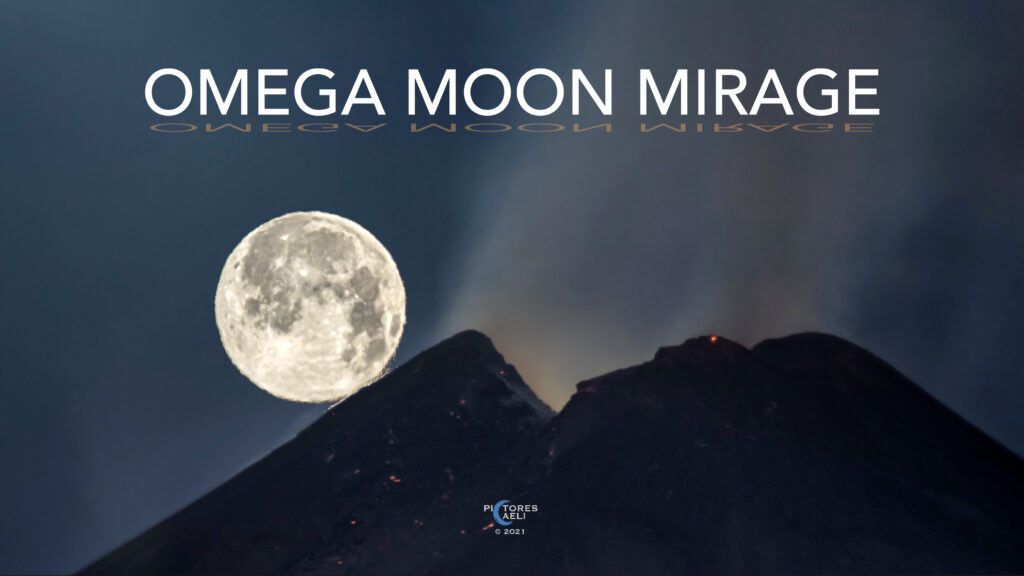
MILO – On February 27, 2021, the photographers Marcella Giulia Pace and Alessia Scarso went to Fornazzo (CT) to shoot the Moon setting over the South-East Crater of Etna that in previous days had given spectacle with high fountains of lava. At 5:30 a.m., compatibly with Covid’s restrictions, they reached the location from Milo and set up the instrumentation and the telephoto lenses with the intention of filming the Moon “soaking on the still smoking crater”.
“It always starts with an ecstatic moment: the search for the contemplation of the moment. Stopping, observing and enjoying it. In those moments a sort of triangulation occurs between eye, lens and observed reality. The aesthetic moment arrives at the verification of the work: there you realize how much of what you have experienced has been impressed in the shots. It’s also the moment in which surprises arrive” says Alessia Scarso.
Unexpectedly, in fact, a phenomenon called “Omega mirage”.
At sunset, as well as at dawn, layers of air of different density (due to different temperature) generate particular types of mirages that occur on the lunar or solar disk during their passage on this band. One of these mirages is called the Omega or Etruscan Vase Mirage.
“The mirage is an optical illusion, in particular the one at Omega is so defined for the characteristic shape that assume the Sun or the Moon in their approach to the marine horizon line: the shape of the capital greek letter “O” (Omega, in fact), by someone also defined “Etruscan Vase”. It is a so called “inferior” mirage, a phenomenon that for example we observe on the asphalt road during the hot days of Sun, generated by the exchange of temperature. It is observed especially on the water during the temperature exchange between air and water: on the sea, for example, the density of the air intensifies, the sunlight is refracted and the image of the lower flap is reversed and reflected on the horizon line” explains the astrophotographer Marcella Giulia Pace.
The same mirage presented itself to the eyes of the two astrophotographers at 3,300 meters above sea level and with the Moon. It was generated by the exhalation of gas and smoke from Etna in activity. The Moon was crossing diagonally the sloping ridge of the South-East crater that in the previous days had given spectacle with beautiful paroxysms. Surprisingly, this unusual mirage occurred on a Moon 15° above the horizon.
The video that the two astrophotographers made documents one of the only representations of this phenomenon at an altitude of 3300 mt.
”We photographed as always in total autonomy from each other, albeit next to each other. When we realized we had captured this particular phenomenon we checked our shots and they were compatible for a merger. Marcella had exposed the moon, I had exposed the volcano. The sum of our sequences completed perfectly. The result is a correct and beautiful scientific data. That’s how you combine science with aesthetics”.
The location chosen by Marcella and Alessia is about 10 km from the Southeast Crater of Etna. Marcella explains that “this distance has greatly influenced the thickness of the mirage that appeared very thin. The lower edge of the Moon seems to tip over the edge of the crater anticipating the crossing and the entire lunar disk, immersed in the strong turbulence, seems to liquefy”.
A passion, that for astrophotography, that Marcella Giulia Pace, teacher, and Alessia Scarso, director, both members of the group of astrophotographers Pictores Caeli, often cultivate in the company, sharing planning and curiosity.
“As with many things to sustain the long preparations, the study of the positions and movements of the sky, the sleepless nights and the long waits you need a substantial dose of passion. In this case, a passion for the unexpected”.
Alessia Scarso www.alessiascarso.it IG – @alessia.scarso
Marcella Giulia Pace www.greenflash.photo IG – @marcella_giulia_pace
Read more about the mirage at Omega here

